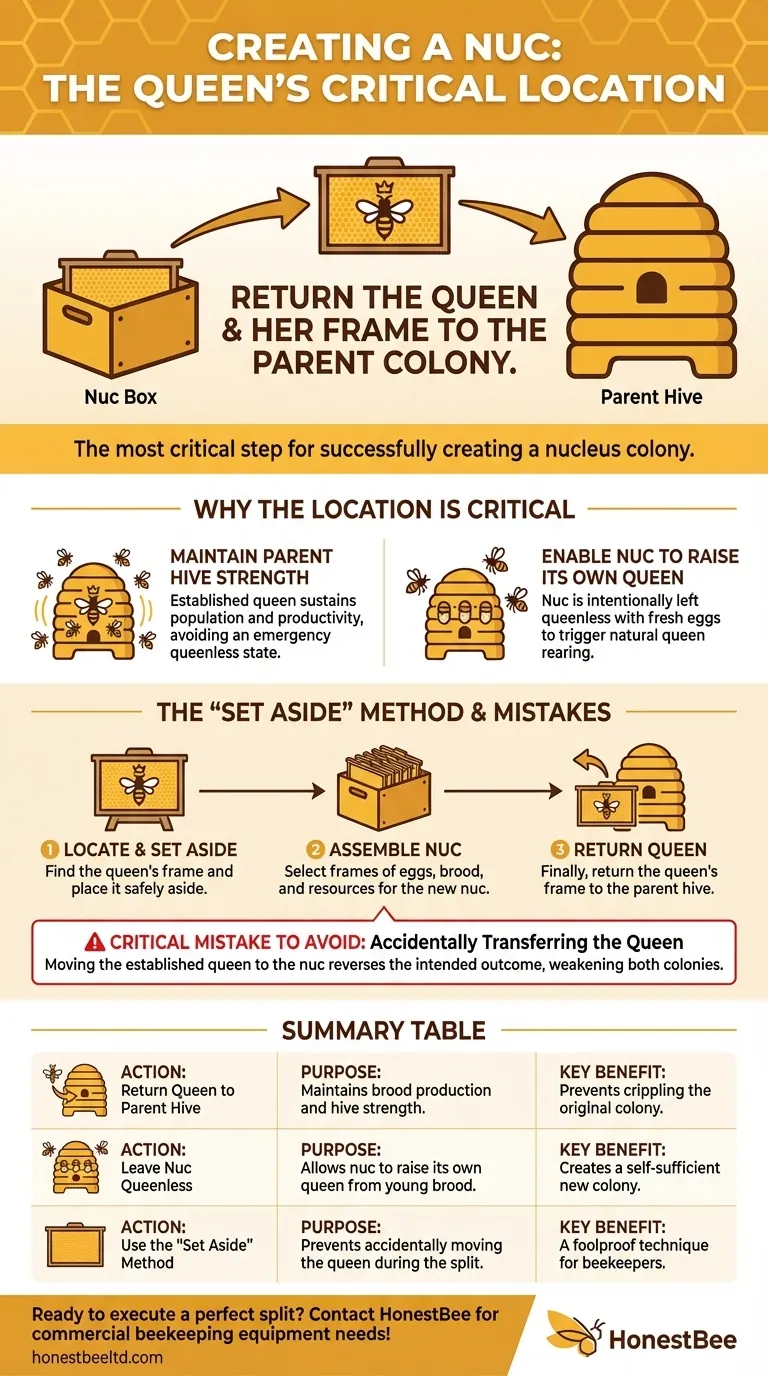In short, the queen and her frame must be returned to the original parent colony. This single action is the most critical step in successfully creating a nucleus colony, or "nuc," without crippling your strong, productive hive. The entire process is designed to ensure the parent colony remains strong and the new nuc has the resources it needs to raise its own queen.
The fundamental principle is to keep your established, egg-laying queen in the strong parent hive to maintain its population and productivity. The new nuc is intentionally left queenless with fresh eggs so it can raise a new queen of its own.

Why the Queen's Location is Critical
Splitting a hive is a delicate balance. You are creating a new colony, but the primary goal is to do so without severely weakening the original one. The queen's location determines the fate of both hives.
Maintaining the Parent Colony's Strength
The established queen is the engine of the parent colony. She is responsible for laying the hundreds or thousands of eggs per day that sustain its workforce.
Removing her would immediately render the hive queenless. The colony would be forced into an emergency state, halting brood production for weeks as they raise a new queen, get her mated, and wait for her to begin laying. This can decimate honey production and leave the hive vulnerable.
The Purpose of a "Walk-Away" Split
The most common type of nuc is a "walk-away split," where the beekeeper provides the new, smaller colony with all the necessary resources to raise its own queen.
These resources are frames containing fresh eggs and very young larvae. By ensuring the old queen is not in the nuc, you allow the bees in the nuc to recognize their queenless state and begin the natural process of creating queen cells from the young brood you provided.
The "Set Aside" Method: A Foolproof Technique
A common and highly effective technique is to find the queen before you do anything else.
Once you locate the frame with the queen, gently set that entire frame aside in a safe place. This prevents you from accidentally scooping her up as you select other frames of brood, pollen, and honey for your new nuc. After you have assembled the nuc, you simply place her frame back into the parent hive.
The Critical Mistake to Avoid
The consequences of mishandling the queen during a split can be significant and set back your apiary's progress.
Accidentally Transferring the Queen
If you accidentally move the established queen to the new, small nuc, you have effectively reversed the intended outcome.
Your strong parent hive is now queenless and struggling, while your small nuc has a laying queen but lacks the population to properly care for her brood. This creates two weak colonies instead of one strong one and one growing one.
Ensuring You Don't Move Her
The most common error is not confirming the queen's location. If you cannot find her after a thorough inspection, you can take an extra precaution.
Before moving a frame of open brood to the nuc, gently shake all the adult bees from that frame back into the parent hive. This greatly increases the odds that the queen, if she was on that frame, falls back into the correct colony. The nurse bees from the parent hive will quickly move to cover the brood in the nuc.
A Simple Workflow for Success
Your goal dictates the proper action. For most beekeepers creating a nuc, the objective is to multiply their colonies while preserving the strength of the original.
- If your primary focus is a standard split: Your first step should always be to locate the queen. Set her and her frame safely aside, assemble your nuc with frames of eggs and resources, and then return her to the parent hive.
- If you absolutely cannot find the queen: To be safe, gently shake all bees off the brood frames you intend to move, ensuring they fall back into the parent hive before you transfer the frames to the nuc box.
Properly managing your queen's location is the key to turning one strong hive into two healthy colonies.
Summary Table:
| Action | Purpose | Key Benefit |
|---|---|---|
| Return Queen to Parent Hive | Maintains brood production and hive strength. | Prevents crippling the original colony. |
| Leave Nuc Queenless | Allows nuc to raise its own queen from young brood. | Creates a self-sufficient new colony. |
| Use the 'Set Aside' Method | Prevents accidentally moving the queen during the split. | A foolproof technique for beekeepers. |
Ready to execute a perfect split and grow your apiary with confidence? The right equipment is essential for successful hive management. HONESTBEE supplies commercial apiaries and beekeeping equipment distributors with the durable, wholesale-focused supplies needed for productive beekeeping operations. Contact our experts today to discuss your equipment needs and ensure your splits are a success!
Visual Guide

Related Products
- 5 Frame Wooden Nuc Box for Beekeeping
- Plastic Transporting Bee Packages and Nuc Boxes for Beekeeping
- Styrofoam Mini Mating Nuc Box with Frames Feeder Styrofoam Bee Hives 3 Frame Nuc Box
- Portable Bee Mating Hive Boxes Mini Mating Nucs 8 Frames for Queen Rearing
- 5 Frame Langstroth Poly Nuc Corrugated Plastic Nuc Boxes
People Also Ask
- What frames should be moved into the queenless hive when requeening with a nuc? Ensure a Successful Queen Introduction
- What are the benefits of using nucs for beginning beekeepers? Ensure a Successful First Hive with a Head Start
- What are the benefits of moving nuclei around the apiary? Master Strategic Hive Management
- How should the nuc be installed in the apiary? Ensure Colony Success from Day One
- What is a common feature of many 5-frame nuc boxes? The Integrated Feeder for Efficient Colony Growth



















